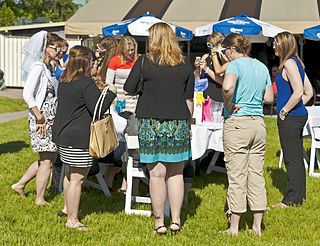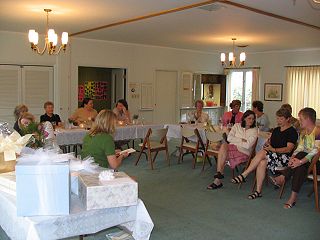
A wedding is a ceremony where two people are united in marriage. Wedding traditions and customs vary greatly between cultures, ethnic groups, races, religions, denominations, countries, social classes, and sexual orientations. Most wedding ceremonies involve an exchange of marriage vows by a couple, presentation of a gift, and a public proclamation of marriage by an authority figure or celebrant. Special wedding garments are often worn, and the ceremony is sometimes followed by a wedding reception. Music, poetry, prayers, or readings from religious texts or literature are also commonly incorporated into the ceremony, as well as superstitious customs.

A wedding reception is a party usually held after the completion of a marriage ceremony as hospitality for those who have attended the wedding, hence the name reception: the couple receive society, in the form of family and friends, for the first time as a married couple. Hosts provide their choice of food and drink, although a wedding cake is popular.
Bridesmaids are members of the bride's party at some Western traditional wedding ceremonies. A bridesmaid is typically a young woman and often the bride's close friend or relative. She attends to the bride on the day of a wedding or marriage ceremony. Traditionally, bridesmaids were chosen from unwed young women of marriageable age.

A groomsman or usher is one of the male attendants to the groom in a wedding ceremony. Usually, the groom selects close friends and relatives to serve as groomsmen, and it is considered an honor to be selected. From his groomsmen, the groom usually chooses one to serve as best man.

A bachelorette party or hen night is a party held for a woman who will soon be married. While Beth Montemurro concludes that the bachelorette party is modelled after the centuries-old stag night in the US, which is itself historically a dinner given by the bridegroom to his friends shortly before his wedding, Sheila Young argues that its British counterpart evolved from a number of earlier pre-wedding traditions for women whose origins are obscure but which have been around for at least a century in factories and offices across the UK. Despite its reputation as "a sodden farewell to maiden days" or "an evening of debauchery", these events can simply be parties given in honor of the bride-to-be, in the style that is common to that social circle.
A stag and doe party, stag and drag party, buck and doe party, a jack and jill party, or a wedding social is a Canadian party and fundraiser for an engaged couple.

A bridal shower is a gift-giving party held for a bride-to-be in anticipation of her wedding.
A rehearsal dinner is a traditional pre-wedding ceremony in the United States, usually held after the wedding rehearsal and the night before the wedding ceremony.

Traditional Russian weddings can last between two days and one week. The celebration usually involves dancing, singing, toasting, and banqueting. The best man and bridesmaid are called "Witnesses" or "Свидетели" in Russian. The ceremony and the ring exchange take place on the first day of the wedding. Russian weddings ceremonies have undertaken a certain amount of Western traditions, including incorporating maids of honour into the wedding party.
Polterabend is a German and to a lesser extent Polish, Austrian and Swiss wedding custom in which, on the night before the wedding, the guests break porcelain to bring luck to the couple's marriage. The belief in the effectiveness of this custom is expressed by the old adage: "Shards bring luck". The expression is derived from a time when the word "shard" referred to the unbroken clay pots of pottery makers, and not just the broken pieces. It was said that a full jar was a lucky thing to have, therefore the expression "shards bring luck".

An engagement party, also known as a betrothal party or fort, is a party held to celebrate a couple's recent engagement and to help future wedding guests to get to know one another. Traditionally, the bride's parents host the engagement party, but many modern couples host their own celebration.

A divorce party is a ceremony that celebrates the end of a marriage or civil union. They can involve either one or both members of the separating couple. Divorce parties have been called the final frontier in the wedding industry complex, and often involve a toast that emphasizes the couple beginning new chapters in their lives.
Arabic weddings are ceremonies of matrimony that contain Arab influences or Arabic culture.
In the United States and Canada, weddings follow traditions often based on religion, culture, and social norms. Most wedding traditions in the United States and Canada were assimilated from other, generally European, countries. Marriages in the U.S. and Canada are typically arranged by the participants and ceremonies may either be religious or civil. There is a tradition that the prospective bridegroom ask his future father-in-law for his blessing.

A Bou bhat is a post-wedding ritual held usually one or two days after a Bengali wedding. In this ceremony a party is hosted by the groom's father or family, where both the bride's and groom's family members and friends are invited. A grand banquet is held at the end of the party which is called Preetibhoj or Preetibhoja and is similar to a gala dinner. In Bengali Muslim wedding after the bou bhat party, the bride and groom go to the bride's family's house for two nights. On the second day, the groom's family is invited to the bride's house for a meal, and they leave with the bride and groom. This meal is called firani or araiya. Shopping is done by the groom for this meal. Similar tradition can be found in other cultures in the Muslim world such as the Walima ceremony.

The Azerbaijani wedding tradition is one of the most significant and solemn family traditions of Azerbaijani people. It is multi-stepped, and is related to various compulsory rituals and traditions. Ancient Azerbaijani weddings reflect cycles of traditions, lasting for a long period of time, and need significant material costs.
Don't Tell the Bride is an Australian reality television series premiered on Network Ten on Tuesday 21 August 2012. Presented and narrated by Kate Ritchie, this series was an adaptation of the UK series Don't Tell the Bride that screened on BBC Three.

Last Vegas is a 2013 American comedy film directed by Jon Turteltaub, written by Dan Fogelman and starring Michael Douglas, Robert De Niro, Morgan Freeman, Kevin Kline and Mary Steenburgen. Three retirees travel to Las Vegas to have a bachelor party for their last remaining single friend.

An Oaxacan wedding is a traditional ritual that involves the participation of both the bride's and groom's family along with the community. The main decision makers of the wedding are the fathers of the groom and bride. The father of the groom must first ask for the bride's hand and if the bride's father accepts two weeks later they begin to arrange the wedding. If the case is that the groom does not have a father he can have an elder represent him. At this gathering the groom's side of the family brings with them fruits, bread, and alcoholic beverages. The godparents of both the bride and groom attend this gathering, who are the godparents of baptism, first communion, confirmation, as well as the new wedding godparents of the couple. The godparents are chosen by the couple usually because of a blood tie or a friendship. After this the groom must show his commitment to his bride's family by doing any chores the bride's family needs until the wedding date. The chores can vary from sweeping to helping the father in law with work in the ranch.












